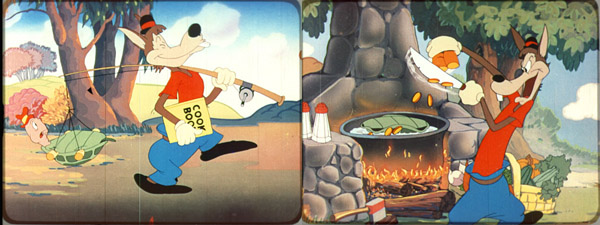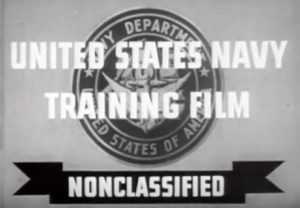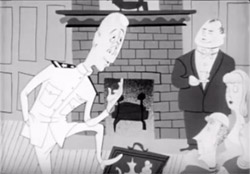
A simple post today, and back to meetings and eventually cleanup!
In Thunderbeanland:
The plate is still full of stuff here, although it seems to be well separated into nice neat portions at the moment. I’m concentrating on trying to completely finish the Noveltoons Blu-ray *this week* and send it off from replication. Our own Jerry Beck was kind enough to lend his print of The Old Shell Game dug out of storage at the last minute (for him *and* me!). This rare 35mm Technicolor print is worn and suffering the ravages of the dreaded ‘vinegar syndrome’ but I think we got an acceptable scan out of it yesterday, and it’s in cleanup between myself and two others. All other elements for that set are now done- wish me luck in not having Noveltoons as an “in-progress” project!

I’m going to try to get my head away from all the projects and logistics and things and concentrate on something not related this week. It’s a heavy lift right now to try and accomplish a few big things this week. I’l report the results in next week’s post.
Last week’s post had great comments! I really wish I wasn’t an infant (under a year old) when that Tex Avery show happened…
 I’m scanning a film this week from WW2, produced by Disney. While there’s a good amount of these shorts in existence at the National Archive, there’s also pretty large gaps of missing ones. It will be arriving via FedEx later today, and since these war shorts were on my mind, I thought it would be fun to visit a few of the shorts that UPA made.
I’m scanning a film this week from WW2, produced by Disney. While there’s a good amount of these shorts in existence at the National Archive, there’s also pretty large gaps of missing ones. It will be arriving via FedEx later today, and since these war shorts were on my mind, I thought it would be fun to visit a few of the shorts that UPA made.
Sometimes I think *all* my articles here should have the tagline ‘Assisted by Kausler’ (ala the Betty Boop title card), since so many of the missing links and cool things reside in his archive. When we were first rebooting my little video company idea, in 2004, Mark was kind enough to lend a missing piece to nearly everything we were doing – and still does! Cartoons for Victory, a set of cartoons from World War 2, was especially ‘assisted’, and there were so many films I had never seen before in a scan session we did right across from the Warner’s lot. Someone in the suite next to us was editing Desperate Housewives episodes or color correcting or something, and I remember the volume in our Telecine suite was quite low, so modern television invaded frequently!
 Two of the films scanned that day, After the Cut and Landing Accidents (both 1946) were produced for the Navy. These ones are especially hard to come by since much of the Navy material doesn’t seem to have made it to the National Archives, leaving vintage prints from around the era being the only copies available. I do hope at *some point* this situation is remedied if indeed these all exist somewhere in the government’s film archive. Funny enough, I may have stumbled into where some of these things are, but am hard pressed to access them at this point in time.
Two of the films scanned that day, After the Cut and Landing Accidents (both 1946) were produced for the Navy. These ones are especially hard to come by since much of the Navy material doesn’t seem to have made it to the National Archives, leaving vintage prints from around the era being the only copies available. I do hope at *some point* this situation is remedied if indeed these all exist somewhere in the government’s film archive. Funny enough, I may have stumbled into where some of these things are, but am hard pressed to access them at this point in time.
It’s interesting to note that the company is credited as being ‘United Film Productions’ here. This same company name appears through much of the paperwork from productions made for war. I imagine they made this choice based on the original name of the company, ’United Poster Service’.
These two films really show that UPA was already well on its way to combining many design ideas into a single short, regardless of the congruency of style throughout the film. It’s interesting to note that UPA is billed, as perhaps training films were the perfect place to experiment in this way; I have to wonder if these experiments were even noticed or applauded higher up, or if all of the graphic choices beyond story were left to the filmmakers (it seems likely so).
 After the Cut’s combination of ‘usual’ American cartoon styling and highly stylized characters and movement is especially interesting; I have to wonder if this is the first time some of these ideas were used next to each other in a film. John Hubley is likely the director of Landing Accidents, and I would guess Bob Cannon may have directed After the Cut. The Saul Steinberg-inspired design sensibility in After the Cut would appear again in Brotherhood of Man (also 1946). I especially love all the crash faces of the planes in this short. Note that their designs are very similar to the later Disney short Susie the Little Blue Coupe. I have to wonder if there’s a connection there. In many of the war shorts, it’s clear that the limited animation is related to the budget allocated for each particular film. I have to wonder if United Film’s budgets ran over on these shorts.
After the Cut’s combination of ‘usual’ American cartoon styling and highly stylized characters and movement is especially interesting; I have to wonder if this is the first time some of these ideas were used next to each other in a film. John Hubley is likely the director of Landing Accidents, and I would guess Bob Cannon may have directed After the Cut. The Saul Steinberg-inspired design sensibility in After the Cut would appear again in Brotherhood of Man (also 1946). I especially love all the crash faces of the planes in this short. Note that their designs are very similar to the later Disney short Susie the Little Blue Coupe. I have to wonder if there’s a connection there. In many of the war shorts, it’s clear that the limited animation is related to the budget allocated for each particular film. I have to wonder if United Film’s budgets ran over on these shorts.
On a side note, I found another interesting short I hadn’t seen called Accident Injury Prevention (I think from 1948):
There is no complete list of all the World War two (and soon after) cartoons produced for the government at this point. The GrandPaw Pettybone shorts much more recently made their appearance, and I’m hoping at some point to dive back into the whereabouts of more of these films once a few more things are off those already stated plates above.
Have a good week everyone!


 Steve Stanchfield is an animator, educator and film archivist. He runs Thunderbean Animation, an animation studio in Ann Arbor, Michigan and has compiled over a dozen archival animation DVD collections devoted to such subjects at Private Snafu, The Little King and the infamous Cubby Bear. Steve is also a professor at the College for Creative Studies in Detroit.
Steve Stanchfield is an animator, educator and film archivist. He runs Thunderbean Animation, an animation studio in Ann Arbor, Michigan and has compiled over a dozen archival animation DVD collections devoted to such subjects at Private Snafu, The Little King and the infamous Cubby Bear. Steve is also a professor at the College for Creative Studies in Detroit.






















I recall a number of years ago when some of the black-and-white “Hook” cartoons first appeared from Norman Hatch’s archive. Last I recall, three of them surfaced, “Tokyo Woes” (Clampett), “The Good Egg” (Jones), and “The Return of Mr. Hook” (McKimson, in one of his first directorial jobs, I think). There was also the colour job done at Lantz. Hank Ketcham mentions the series in his memoirs. I assume this series suffered from the issue you describe above. Has anyone ever figured out how many were made in the series, and have any more turned up?
Hmm.”The Good Egg”, Jones. Not to be confused with that cute Disney like EARLIER Jones/Good Egg cartoon from 1939.:-)
I know the Ted Eshbaugh Studios were contracted to do training films for the Navy, unfortunately I’ve yet to see any training films credited to him.
Also, FYI, I’ve had several former Jam Handy employees tell me that during World War II that JHO and several of the other industrial film outlets located in Detroit were rolling out more film than was produced in Hollywood yearly as they were mass producing films for the armed forces and the Homefront (both motion pictures and filmstrips). JHO, who was the first studio to get the Army-Navy E award, was the first choice by the military (aside from their internal motion picture unit) to do their films, because of how affective they were. If a complete filmography of ALL of these government films were to exist I imagine it would be a MASSIVE list and an extremely heavy book!
Bill Conrad narrating “Accident Injury Prevention,” I see…
Here is a link to another U.S. Navy training film titled “Bailing Out.”
https://www.youtube.com/watch?v=0sd6R0aBJkE
Too bad they plastered an ad all over the year data in the closing card. It’s 194X, and looks like either 1945 or 1946.
Copyright date is in Roman numerals at the very start: MCMXLIX – 1949. You can also see 1949 at the end when you’re pulling the scrub bar – the ads don’t show when you’re doing that.